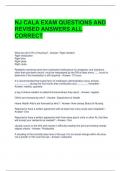NJ CALA EXAM QUESTIONS AND
REVISED ANSWERS ALL
CORRECT
What are the 5 R's of Nursing? - Answer- Right resident
Right medication
Right time
Right dose
Right route
Residents receiving short-term scheduled medications for analgesia, and injections,
other than pre-dawn insulin, must be reassessed by the RN at least every ___ hours to
determine if the medication is still required - Answer- 72 hours
It is recommended that supervision of medication administration occur at least
___________ during the first month after certification and ________ thereafter -
Answer- weekly, quarterly
a log of where resident is (date/time/name/where they went) - Answer- register
CNA's are licensed by who? - Answer- Department of Health
Home Health Aide's are licensed by who? - Answer- New Jersey Board of Nursing
Required to have a written agreement with at least how many acute care hospitals? -
Answer- One
Required to have a written agreement with how many psych units or other AL that they
will accept your residents as needed? - Answer- One
Usually occurs in the 40's and results in difficulty reading fine print and seeing nearby
objects clearly - Answer- Presbyobia
A clouding of the normally clear lens of the eye. It is an actual change within the lens,
not a growth or film over the eye - Answer- Cataracts
, gradual loss of peripheral vision, which is what makes you aware of things beside,
above and around you, even when you look straight ahead - Answer- glaucoma
damage or breakdown of the macular, an area 3/16 inch in diameter, in the retina. It
causes loss of central or straight-ahead vision - Answer- macular degeneration
sound waves are not conducted to the inner ear. The cause may be an obstruction in
the outer ear (an accumulation of wax or blockage caused by swelling and pus) or a
problem in the middle ear (fluid in the middle ear or fixation of one or more of the middle
ear bones) - Answer- conductive loss
sound waves reach the inner ear, but are not properly transmitted to the brain - Answer-
sensorineural loss
the synovial membrane surrounding the joint becomes inflamed. The disease shifts from
one part of the body to another, but affects both sides similarly. It usually involves the
small joints of the wrists, knuckles of the hands, and balls of the feet, at different times -
Answer- rheumatoid arthritis
How do you treat rheumatoid arthritis? - Answer- reduce pain and inflammation and
preventing muscles from wasting away
involves the major moveable, weight-bearing joints (hips, knees, lower spine) and the
joints nearest the fingertips and at the base of the thumb big toe - Answer-
Osteoarthritis
How do you treat osteoarthritis? - Answer- manage pain (and inflammation), reduce
stress on joints, maintain flexibility and muscle strength, and prevent further harm to
joints. Treatment plan usually involves a combination of exercise, medication, heat and
cold treatments, and joint protection
Symptoms of DM 1 - Answer- Increased thirst, frequent urination (increased volume),
rapid weight loss, blurred vision
Symptoms of DM 2 - Answer- tiredness/fatigue; blurred vision/difficulty focusing;
numbness and tingling hands and feet; frequent infections, slow healing cuts and sores;
dry, itching skin; increased thirst (less common); frequent urination (less urination)
Hypoglycemic medication side effects - Answer- rashes, redness, itching, yellow color,
nausea/vomiting, heartburn, abdominal fullness, gas, diarrhea, fever, tiredness, sore
throat, unusual bleeding, decreased appetite
____ is the minimum number of hours for administrator training, plus ____ hours at a
license facility - Answer- 40 hours, 16 hours




